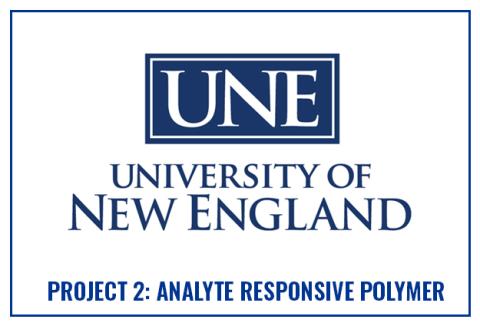
Dr. Eva Rose Balog
University of New England
Focus
Achieving predictable protein function when proteins are integrated into biotechnology applications and manufacturing environments towards engineering principles of context-dependent recognition element activity, in the context of analyte-responsive polymer materials.
Purpose
The purpose of this project is to couple analyte-binding via recognition elements (REs) to a molecular activity that transduces information about the binding status to a sensor surface. This transduction activity relies on a genetically-engineered protein component called an elastin-like polymer (ELP). ELPs have been studied for over 30 years, often with an eye toward biosensing applications, but their potential has yet to be realized. We hypothesis that a substantial barrier to predictable ELP function in the context of devices and nanomaterials is the knowledge gap between how proteins behave in solution, where they are most frequently studied, versus how they behave immobilized on surfaces; and how modular protein components function separately versus how each function is influenced when components are physically linked together. This project aims to fill in these knowledge gaps with engineering principles toward predictable design of an RE-ELP construct termed an analyte-responsive polymer (ARP).
Major Industry Challenge
Proteins with compelling functions (e.g., molecular recognition, stimuli-responsive “smart” polymer behavior), are not efficiently translated into industrially viable sensors. This is in part because elements of the sensor fabrication process, such as labeling proteins with probes or immobilizing them on a surface, are often incompatible with stable protein function. If it were easier to design proteins to perform within the context of a given application or independent of context, developing protein-based sensors would be dramatically simplified.
Hypothesis
The study of analyte-responsive polymers (ARPs) with tunable analyte binding and stimuli-responsive behaviors will directly enable the development of engineering principles for rapid functional protein integration into sensors and other biotechnology.
Project Goals
- Generate libraries of analyte responsive polymers
- Characterize the robustness of analyte binding and stimuli-response behavior within these libraries
- Extract and model biochemical parameters that contribute to functional robustness and context-(in)dependence Major Outcomes We will design, produce, and characterize ARP libraries (i.e., physical DNA plasmids and associated data and metadata) for incorporation into the sensors described in Projects 3 and 4. We will discover engineering principles that allow predictive, efficient design of ARPs based on end-user input of descriptive and quantitative factors, such as the physicochemical properties of the recognition
